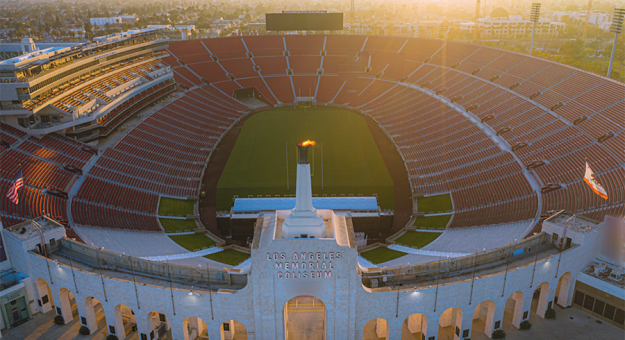Muldowney estimated that 10,000 cubic yards of earth would be hauled into the stadium at night in roughly 650 truckloads to serve as the track’s “subsurface.” That stage was estimated to take two weeks to complete.
Then came the track paving, with about 2,500 tons of asphalt being put down for the track surface and infield.
“Sounds like a lot, it is a lot, but in the scheme of building typical race tracks, it’s not a lot,” Muldowney said.
SAFER barriers are being brought in from Auto Club Speedway in Fontana, 50 miles east of the stadium. The project is also getting a hand from the Grand Prix of Long Beach, which will supply barriers and catchfence.
“Putting a race track in a facility like the Coliseum has been talked about here internally, for many, many years,” said Muldowney, who was part of a group that once visited Soldier Field in Chicago when it was considered for the project.
When the Coliseum project was initially presented to Muldowney as something NASCAR was going forward with, he was “skeptical at first.”
“But then as we got more into it and looked at what it’s really gonna take and what the final product is really gonna look like, I kind of became a believer,” he said. “This is going to be successful, I’m convinced of it. … When it is successful, it’s a model that can be brought to a lot of different places, not just here, but really worldwide.”
The Main Event
What will NASCAR’s big experiment with going small look like once the green flag waves at the Coliseum?
A handful of current Cup Series drivers, including Chase Elliott, Kyle Larson and Justin Haley, got a taste of Bowman Gray over the course of five ARCA Menards Series East races between 2011 and ’15.
“There wasn’t a lot of passing at Bowman Gray,” said Haley. “Obviously, there’s some bumping and that makes it exciting. … I don’t know if you could pass if you wanted to, it’s not like there’s an outside groove or anything. … With the Next Gen cars, we’ve got maybe some shifting capabilities to kind of get (better passing possibilities) … it’s just so hard when you slow the apex down that much and then try to get a run off.”
The club of active Cup Series drivers who can say they’ve won a modern stock car race on the track the Coliseum project is based is very exclusive. Since Matt DiBenedetto doesn’t have a Cup Series ride this season, Corey LaJoie, winner of the 2012 race, will be its only member.
“I think it’s gonna be better than what people anticipate,” LaJoie said. “I don’t anticipate the racing being like, tremendous side-by-side just because we’re racing around a running track essentially. … It’ll definitely bend some fenders as much as it’ll bend some feelings before we get to Daytona.”
In a fresh market, with a new car on an unproven track, NASCAR has a lot riding on the Clash as a building block for its future.
During his state of the sport address in November, NASCAR President Steve Phelps called the Clash a “proof point” that NASCAR will “be bold in what we’re doing … we’re going to take calculated risks.”
How will we know if this calculated risk is worth the investment?
According to Rodgers, info NASCAR receives from its partnership with Ticketmaster (the official ticket provider for the Coliseum) showed at least 50 percent of tickets purchased for the Clash by mid-November were by people who had never attended a NASCAR race (or weren’t in NASCAR’s database).
For Brad Keselowski, the number of new eyeballs on the sport makes the Clash worthwhile regardless of how much resources are invested in it or the race’s quality.
“I know there are some people that don’t like the fact that we’re traveling all the way to L.A.,” said the driver and co-owner of RFK Racing’s No. 6 Ford. “But look, our average plane flight is one to two hours. So we have a four-hour plane flight and the hauler driver has to drive a little longer.
“It seems a little short- sighted to be overly concerned about that. We’re getting to a new market with new people. And I think that’s going to be a good opportunity for us to create that event atmosphere.”
Keselowski added a reminder about the nature of the Clash.
“The great thing is it’s an exhibition,” he said. “So if it’s a complete pile of crap, that’s OK. We’re trying things.” n
